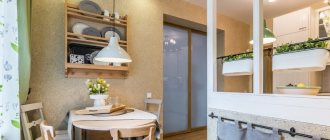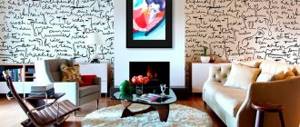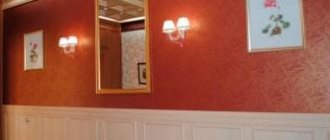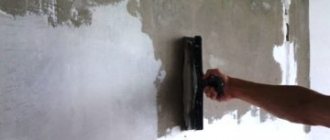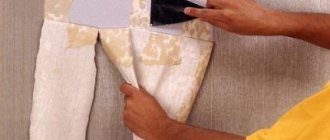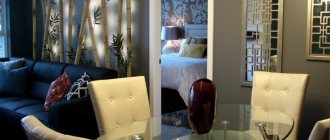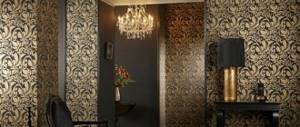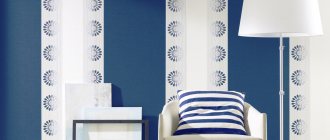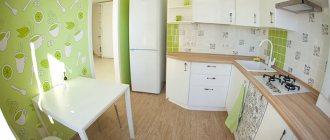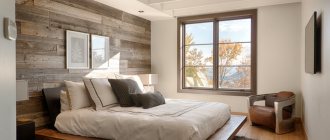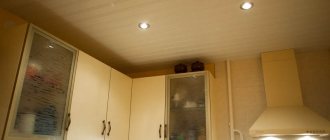What is liquid wallpaper made of?
Some believe that liquid wallpaper is plaster, just of a rather non-standard appearance. In fact, this is almost true, but this “plaster” does not contain the main component – sand.
Liquid wallpaper is a mixture of binders, adhesive substances and plasticizers (mainly cellulose) and decorative filler, mainly of natural origin. For example: silk fibers, glitter powder, mica particles, and dyes.
In dry form, it is an ordinary building mixture that must be diluted with water until the required consistency is obtained. Then the mixture is applied to the walls using a spatula. Almost anyone can cope with this, since, unlike natural plaster, this fibrous mixture is more pliable and less capricious.
The result is a coating that feels like fabric wallpaper, has a structure, but is completely devoid of seams.
Purpose of the room and finishing with liquid wallpaper: when appropriate
To ensure that the application of liquid wallpaper does not disrupt the functionality of the surface, you need to understand where the use of mixtures is appropriate and where it is not. Made from a water-based solution, ceiling mixtures tend to absorb moisture and allow air to pass through. That is why it is important to select rooms with normal or low humidity levels for finishing. This option is not appropriate in the bathroom, kitchen, and especially in a sauna or swimming pool.
The ability of finishing to “breathe” should be used when planning the decor of children’s rooms, a living room or bedroom, where you need to work on creating a beautiful, practical and environmentally friendly coating.
What types of liquid wallpaper are there?
There are two main types: professional mixtures and amateur ones. The first ones are without dye, but they are much more affordable. But the master needs to know exactly how much paint to add to the mixture.
The second option is completely ready for use, has a specified color. That is, just add water.
In addition to this division, liquid wallpaper differs in the types of main filler:
- Cotton
- Silk
- Cellulose
- Blend of silk and cellulose
That is, the more natural the material, the more expensive these coatings are. Silk ones are the most expensive, but they are worth spending money on. This is a fairly durable coating and the cotton version is much inferior to it.
Cellulose mixed with silk is an alternative option, it is more affordable, has all the advantages of natural fillers, but is not a completely natural substance. However, this option is no worse and can also be considered an environmentally friendly solution.
Liquid finishing: concept and consumption
Liquid wallpaper is sold in the form of a dry mixture of different shades with structuring elements included in the composition. The latter influence the formation of a pattern with one or another texture.
It is believed that finishing the ceiling with such mixtures is one of the most convenient, fastest and economical options. Manufacturers claim consumption of one package per 3-5 square meters with a layer thickness of no more than 1.5 mm. Achieving such thickness is not so easy. For this, the ceiling surface must be perfectly flat, and the movements during application must be clear and precise.
To create relief patterns, you will need at least twice as much mixture.
What are the advantages of liquid wallpaper for the ceiling over paper wallpaper?
Liquid wallpaper has many advantages over conventional coatings, such as wallpaper and simple putty.
Firstly, they look much more interesting, and secondly, finishing the ceiling with liquid wallpaper is possible on any plane, even convex. They are very suitable for multi-tiered ceilings and places with corners that are very difficult to trim with paper without getting bends, distortions and other defects.
The coating looks solid, cast and completely smooth.
But these are all only external advantages. There are also practical ones.
- 1. Liquid wallpaper is easy to restore. If a piece is damaged (for example, the building has begun to shrink and a chip has formed), or there has been a small flood from neighbors above, the damaged fragment is cleaned off with a spatula and “patched” with a freshly diluted mixture. That is why it is recommended to take liquid wallpaper a little in excess, so that later you can easily restore some damaged areas.
- 2. It’s much easier to apply them yourself than to wallpaper the ceiling or putty it perfectly. One person can easily handle the application of such a coating, without the involvement of specialists or assistants.
- 3. In terms of price, they are quite a bit more expensive, but their durability is several times greater (particularly due to the fact that they can be restored).
- 4. Liquid wallpaper is not subject to fading and does not lose color for a very long time, unlike paper rolls.
- 5. This coating allows air to pass through well, therefore, the risk of fungal infection and dampness is almost zero.
- 6. It is impossible not to notice that liquid wallpaper slightly muffles the sound and is, at least slightly, an obstacle to noise.
- 7. If a crack forms on the wall, over time, nothing will be visible under the liquid wallpaper, since it is plastic.
- 8. Also, there is no need to putty the surface perfectly evenly, getting rid of the smallest crack and scratch. A mixture of liquid wallpaper hides many wall defects. But there is no need for fanaticism either, the wall should be fairly even, and not completely without preparation.
But that's not all. Liquid wallpaper is good from an environmental point of view. They are hypoallergenic and suitable for people who have reactions to chemicals and dust.
What can you say about the cons? Yes, they don’t exist; in fact, it’s difficult to come up with something. The only thing is that the colors are very much for everyone. But, if you are satisfied with just such effects, then don’t look for shortcomings, there are none.
With a lot of creaking, the disadvantages include a long hardening time, about two days. But... What's the difference? What's the hurry?
What comes first - liquid wallpaper or suspended ceiling
A stretch ceiling is a complex suspended structure made of fabric covering and profile. When asking the question: “what to start with first, liquid wallpaper or suspended ceiling,” you should decide on the amount of work planned in this room.
Before applying liquid wallpaper to the surface, you should first complete all repair work associated with the installation of a stretch ceiling
Namely:
- If you plan to completely renovate both the walls and the ceiling, then it is wiser to first start with installing a stretch ceiling.
- If the walls are already covered with liquid wallpaper or replacing them is not included in the plans at all, then there are no options; the ceiling is installed on finished walls.
In the latter case, it is wise to cover the walls with film to prevent dust and debris from settling on the wallpaper.
Related article: What do ceiling curtains for suspended ceilings look like and how to properly attach them
Typically, the base for leveling walls is made of plasterboard.
Stretch ceilings can only be installed on completely dry walls.
Options for using liquid wallpaper on the ceiling
Now, let's move on to the practical part and see how you can use this material on the ceiling. The scope for imagination here is simply unlimited. Not only can you play with the difference in textures, you can also make drawings with them! Look at this photo, this is how it looks in the interior.
The rose is made from one type of mixture, and the background is made from another. And most importantly, almost everyone can do it all with their own hands.
It also looks interesting when liquid wallpaper is combined with a smooth, painted surface. Let's say you can decorate the box around the perimeter of the room smooth, but make the inside textured.
It looks no worse than a suspended ceiling! And what’s good is that the application technology is simple, but the appearance is very solid. The main thing here is to choose the color well.
You don’t have to mix textures, but create contrasts only with liquid wallpaper.
I would like to note that it would be very nice to duplicate the volumetric texture of the ceiling somewhere on the walls. For example, decorate columns or arches with liquid wallpaper. Then the ceiling will look very organic.
Learn how to create a pattern on the ceiling using liquid wallpaper
Liquid wallpaper can be used to create quite interesting panels. This type of finish will decorate any surface and the room as a whole. The technology for creating a pattern with your own hands on the ceiling is quite simple, with the exception of the process of painstaking work on a hill, with your hands raised up.
Related article: Lattice for gazebos: types and self-production
You can make the interior of a guest room unusual with the help of an original pattern on the ceiling using liquid wallpaper
Step-by-step process of creating a drawing:
- Using a pencil, apply the design to the finished surface. You can use a ready-made stencil, made with your own hands or purchased in advance in a special store.
- Dilute liquid wallpaper for work.
- Apply the prepared wallpaper to the ceiling in a very thin layer, retreating a few millimeters beyond the drawn contour.
- Using the edge of a small spatula, move the wallpaper back, relative to the border of the pattern outline.
- We wait until the fresh material dries: naturally or use a household hair dryer.
- Apply the next shade from the liquid mixture in the form of a strip, retreating a few millimeters from the edge of the dried ones. Using the same spatula, move the “fresh” applied strip of wallpaper close to the dried ones. This way ensures the formation of a clear boundary between different shades of wallpaper, without mixing them.
Small outlines or elements of the picture can be applied with a marker. To express individual elements, you can add various sparkles, threads, beads or small beads to the wallpaper in liquid form in advance.
To create masterpieces, it is better to choose liquid wallpaper with silk fibers. In this case, the drawing should be applied in the same layer!
